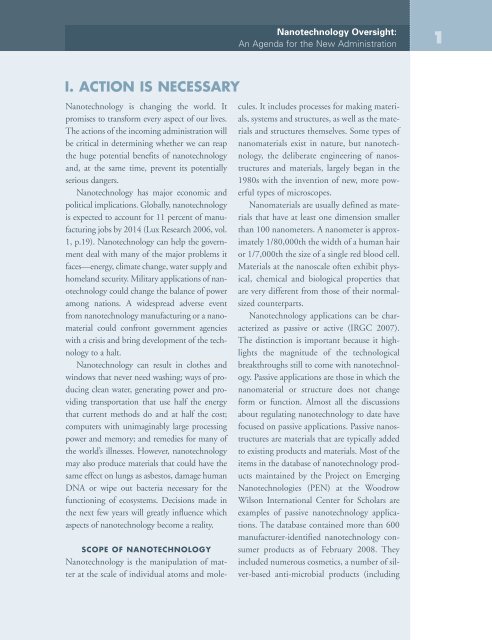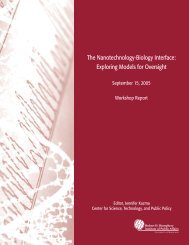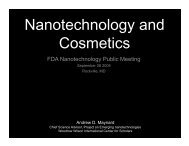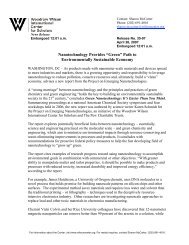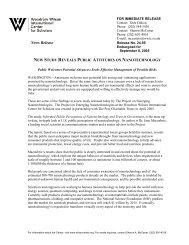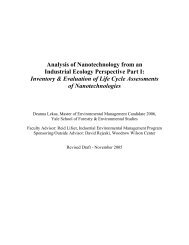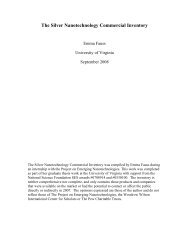nanotechnology oversight - Project on Emerging Nanotechnologies
nanotechnology oversight - Project on Emerging Nanotechnologies
nanotechnology oversight - Project on Emerging Nanotechnologies
You also want an ePaper? Increase the reach of your titles
YUMPU automatically turns print PDFs into web optimized ePapers that Google loves.
Nanotechnology Oversight:<br />
An Agenda for the New Administrati<strong>on</strong><br />
1<br />
I. ACTION IS NECESSARY<br />
Nanotechnology is changing the world. It<br />
promises to transform every aspect of our lives.<br />
The acti<strong>on</strong>s of the incoming administrati<strong>on</strong> will<br />
be critical in determining whether we can reap<br />
the huge potential benefits of <str<strong>on</strong>g>nanotechnology</str<strong>on</strong>g><br />
and, at the same time, prevent its potentially<br />
serious dangers.<br />
Nanotechnology has major ec<strong>on</strong>omic and<br />
political implicati<strong>on</strong>s. Globally, <str<strong>on</strong>g>nanotechnology</str<strong>on</strong>g><br />
is expected to account for 11 percent of manufacturing<br />
jobs by 2014 (Lux Research 2006, vol.<br />
1, p.19). Nanotechnology can help the government<br />
deal with many of the major problems it<br />
faces—energy, climate change, water supply and<br />
homeland security. Military applicati<strong>on</strong>s of <str<strong>on</strong>g>nanotechnology</str<strong>on</strong>g><br />
could change the balance of power<br />
am<strong>on</strong>g nati<strong>on</strong>s. A widespread adverse event<br />
from <str<strong>on</strong>g>nanotechnology</str<strong>on</strong>g> manufacturing or a nanomaterial<br />
could c<strong>on</strong>fr<strong>on</strong>t government agencies<br />
with a crisis and bring development of the technology<br />
to a halt.<br />
Nanotechnology can result in clothes and<br />
windows that never need washing; ways of producing<br />
clean water, generating power and providing<br />
transportati<strong>on</strong> that use half the energy<br />
that current methods do and at half the cost;<br />
computers with unimaginably large processing<br />
power and memory; and remedies for many of<br />
the world’s illnesses. However, <str<strong>on</strong>g>nanotechnology</str<strong>on</strong>g><br />
may also produce materials that could have the<br />
same effect <strong>on</strong> lungs as asbestos, damage human<br />
DNA or wipe out bacteria necessary for the<br />
functi<strong>on</strong>ing of ecosystems. Decisi<strong>on</strong>s made in<br />
the next few years will greatly influence which<br />
aspects of <str<strong>on</strong>g>nanotechnology</str<strong>on</strong>g> become a reality.<br />
SCOPE OF NANOTECHNOLOGY<br />
Nanotechnology is the manipulati<strong>on</strong> of matter<br />
at the scale of individual atoms and molecules.<br />
It includes processes for making materials,<br />
systems and structures, as well as the materials<br />
and structures themselves. Some types of<br />
nanomaterials exist in nature, but <str<strong>on</strong>g>nanotechnology</str<strong>on</strong>g>,<br />
the deliberate engineering of nanostructures<br />
and materials, largely began in the<br />
1980s with the inventi<strong>on</strong> of new, more powerful<br />
types of microscopes.<br />
Nanomaterials are usually defined as materials<br />
that have at least <strong>on</strong>e dimensi<strong>on</strong> smaller<br />
than 100 nanometers. A nanometer is approximately<br />
1/80,000th the width of a human hair<br />
or 1/7,000th the size of a single red blood cell.<br />
Materials at the nanoscale often exhibit physical,<br />
chemical and biological properties that<br />
are very different from those of their normalsized<br />
counterparts.<br />
Nanotechnology applicati<strong>on</strong>s can be characterized<br />
as passive or active (IRGC 2007).<br />
The distincti<strong>on</strong> is important because it highlights<br />
the magnitude of the technological<br />
breakthroughs still to come with <str<strong>on</strong>g>nanotechnology</str<strong>on</strong>g>.<br />
Passive applicati<strong>on</strong>s are those in which the<br />
nanomaterial or structure does not change<br />
form or functi<strong>on</strong>. Almost all the discussi<strong>on</strong>s<br />
about regulating <str<strong>on</strong>g>nanotechnology</str<strong>on</strong>g> to date have<br />
focused <strong>on</strong> passive applicati<strong>on</strong>s. Passive nanostructures<br />
are materials that are typically added<br />
to existing products and materials. Most of the<br />
items in the database of <str<strong>on</strong>g>nanotechnology</str<strong>on</strong>g> products<br />
maintained by the <str<strong>on</strong>g>Project</str<strong>on</strong>g> <strong>on</strong> <strong>Emerging</strong><br />
<strong>Nanotechnologies</strong> (PEN) at the Woodrow<br />
Wils<strong>on</strong> Internati<strong>on</strong>al Center for Scholars are<br />
examples of passive <str<strong>on</strong>g>nanotechnology</str<strong>on</strong>g> applicati<strong>on</strong>s.<br />
The database c<strong>on</strong>tained more than 600<br />
manufacturer-identified <str<strong>on</strong>g>nanotechnology</str<strong>on</strong>g> c<strong>on</strong>sumer<br />
products as of February 2008. They<br />
included numerous cosmetics, a number of silver-based<br />
anti-microbial products (including


